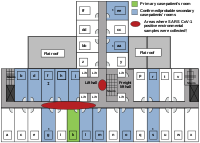
Photo from wikipedia
Objectives The first German SARS-CoV-2 outbreak was a superspreading event in Gangelt, North Rhine-Westphalia, during indoor carnival festivities called ‘Kappensitzung’ (15 February 2020). We determined SARS-CoV-2 RT-PCR positivity rate, SARS-CoV-2-specific… Click to show full abstract
Objectives The first German SARS-CoV-2 outbreak was a superspreading event in Gangelt, North Rhine-Westphalia, during indoor carnival festivities called ‘Kappensitzung’ (15 February 2020). We determined SARS-CoV-2 RT-PCR positivity rate, SARS-CoV-2-specific antibodies, and analysed the conditions and dynamics of superspreading, including ventilation, setting dimensions, distance from infected persons and behavioural patterns. Design In a cross-sectional epidemiological study (51 days postevent), participants were asked to give blood, pharyngeal swabs and complete self-administered questionnaires. Setting The SARS-CoV-2 superspreading event took place during festivities in the small community of Gangelt in February 2020. This 5-hour event included 450 people (6–79 years of age) in a building of 27 m × 13.20 m × 4.20 m. Participants Out of 450 event participants, 411 volunteered to participate in this study. Primary and secondary outcome measures Primary outcome: infection status (determined by IgG ELISA). Secondary outcome: symptoms (determined by questionnaire). Results Overall, 46% (n=186/404) of participants had been infected, and their spatial distribution was associated with proximity to the ventilation system (OR 1.39, 95% CI 0.86 to 2.25). Risk of infection was highly associated with age: children (OR 0.33, 95% CI 0.267 to 0.414) and young adults (age 18–25 years) had a lower risk of infection than older participants (average risk increase of 28% per 10 years). Behavioural differences were also risk associated including time spent outside (OR 0.55, (95% CI 0.33 to 0.91) or smoking (OR 0.32, 95% CI 0.124 to 0.81). Conclusions Our findings underline the importance of proper indoor ventilation for future events. Lower susceptibility of children/young adults indicates their limited involvement in superspreading.
Journal Title: BMJ Open
Year Published: 2022
Link to full text (if available)
Share on Social Media: Sign Up to like & get
recommendations!